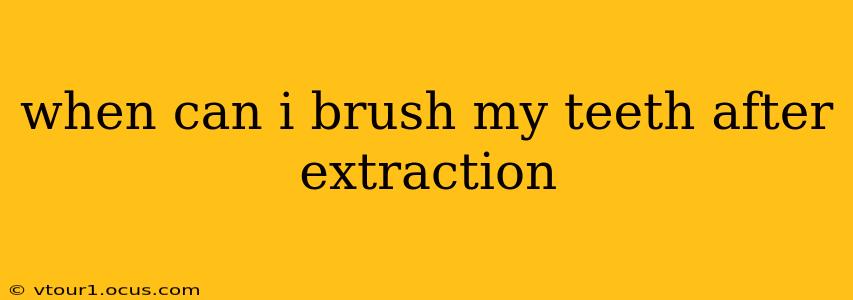Tooth extraction, while a common procedure, leaves your mouth vulnerable. Knowing when and how to brush your teeth afterward is crucial for preventing infection and promoting healing. This guide answers all your questions about oral hygiene post-extraction.
How Soon After Extraction Can I Brush My Teeth?
The general recommendation is to wait at least 24 hours before brushing your teeth near the extraction site. This allows the initial blood clot to form, which is essential for healing and preventing a painful and potentially serious complication called "dry socket." This clot acts as a natural bandage, protecting the exposed bone and nerve endings.
What About Rinsing?
Similarly, avoid vigorous rinsing or spitting for the first 24 hours. Gentle rinsing with salt water (a teaspoon of salt in a glass of warm water) may be recommended by your dentist, but avoid forceful actions that could dislodge the blood clot.
How Should I Brush After 24 Hours?
Once the 24-hour waiting period is over, you can resume brushing your teeth, but with some important modifications:
- Gentle Brushing: Use a soft-bristled toothbrush and brush gently around the extraction site. Avoid directly brushing the area for several days. Focus on the rest of your mouth to maintain good oral hygiene.
- Avoid Abrasive Toothpastes: Opt for a toothpaste that is gentle and non-abrasive. Harsh chemicals can irritate the healing wound.
- Technique is Key: Use short, gentle strokes and avoid putting too much pressure on the gums.
- Angle Matters: Brush at a 45-degree angle to the gum line, rather than directly onto the gums.
What If I Experience Bleeding?
Some minor bleeding is normal in the first few days after extraction. If you experience excessive bleeding, or if bleeding persists for more than a few hours, contact your dentist or oral surgeon immediately.
Can I Use Mouthwash After Extraction?
The use of mouthwash post-extraction is a bit controversial. Some dentists recommend a gentle antiseptic mouthwash after the initial 24-hour period, while others suggest avoiding it altogether until the healing process is more advanced to avoid interfering with clot formation. It’s best to follow your dentist's specific instructions.
What About Dry Socket?
Dry socket (alveolar osteitis) is a painful complication that occurs when the blood clot is dislodged from the extraction site. Symptoms include intense pain, a bad taste, and a visible empty socket. If you suspect you have a dry socket, contact your dentist or oral surgeon immediately as they can provide treatment to alleviate the pain and promote healing.
When Can I Resume My Normal Brushing Routine?
You can generally resume your normal brushing routine after a week or so, as long as the extraction site is healing well and there's no discomfort or bleeding. However, continue to use a soft-bristled brush and gentle brushing technique for several weeks to minimize irritation.
What if I have stitches?
If you have stitches, you will need to follow your dentist's instructions carefully regarding brushing. They may advise you to wait longer before brushing near the stitches, or to use a specific technique to avoid dislodging them.
Disclaimer: This information is intended for general knowledge and does not constitute medical advice. Always consult with your dentist or oral surgeon for specific instructions regarding post-extraction care, as individual needs may vary. They can provide personalized recommendations based on your specific situation and the type of extraction performed.
